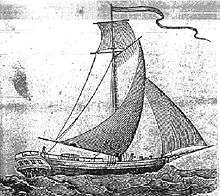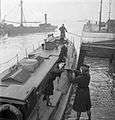Packet boat
Packet boats were medium-sized boats designed for domestic mail, passenger, and freight transportation in European countries and in North American rivers and canals, some of them steam driven. They were used extensively during the 18th and 19th centuries and featured regularly scheduled service.

When such ships were put into use in the 18th century on the Atlantic Ocean between Great Britain and its colonies, the services were called the packet trade. Steam driven packets were used extensively in the United States in the 19th century on the Mississippi and Missouri rivers, supplying and bringing personnel to forts and trading posts.
History
Packet craft were used extensively in European coastal mail services since the 17th century, and gradually added cramped passenger accommodation. As early as 1629, the Dutch East India Company was carrying some passengers on the ill-fated Batavia from Texel in Holland to Java.[1] Passenger accommodations were minimal: transportation, "firing" (i.e. a place to cook), drinking water (often tasting of indigo or tobacco, which the water casks had previously held), and a place to sleep.[2] Later, scheduled services were offered, but the time journeys took depended much on the weather. They are even found to be a subject of Daniel Defoe's 1724 novel Roxana: The Fortunate Mistress.[3] In England the King maintained a weekly packet service with the continent and Ireland using 15 packet vessels.[4] Their importance is evident from the fact that the first craft built in the colony of New South Wales (in 1789) was the Rose Hill Packet.
Over the two centuries of the sailing packet craft development, they came in various rig configurations which included: schooners, schooners-brigs, sloops, cutters, brigs, brigantines, luggers, feluccas, galleys, xebecs, barques and their ultimate development in the clipper ships. Earlier they were also known as dispatch boats, but the service was also provided by privateers during time of war, and on occasion chartered private yachts. News of "record passages" was eagerly awaited by the public, and the craft's captain and crew were often celebrated in the press. Behind this search for sailing faster than the wind however lay the foundations for a development in naval architecture and its science which would serve until the appearance of the steam vessels.
In 1863, during the Civil War, the packet boat Marshall carried the body of Confederate General Stonewall Jackson from Lynchburg to his home in Lexington, Virginia for burial.[5]
Canal packet boats
The American canal packet boats were typically narrow (about 14 feet) to accommodate canals, but might be 70–90 feet long. When the Erie Canal opened in New York state in 1825 along the Mohawk River, demand quickly rose for travelers to be accommodated. Canal packet boats included cabin space for up to 60 passengers. Unlike European and American sailing vessels, that sought to attain greater speed under sail, the canal packet boats were drawn through the Erie Canal by teams of two or three horses or mules. Compared to overland travel, the boats cut journey time in half and were much more comfortable. Travelers could get from New York City to Buffalo in ten days, with a combination of sailing and packet boats. Some passengers took the boats to see both the Erie Canal and the natural landscapes. Significantly, thousands of others used packet boats to emigrate to Ohio and other parts of the Midwest. These boats were also instrumental in the settling of and travel within Upstate New York through the branch canals such as the Chenango Canal. Packet boats were also popular along the James River and Kanawha Canal in Virginia, allowing travel beyond the falls upriver.
Mail steamer

Mail steamers were steamships which carried the mail across waterways, such as across an ocean or between islands, primarily during the 19th century and early 20th century, when the cost of sending a letter was declining to the point an ordinary person could afford the cost of sending a letter across great distances. In addition to carrying mail, most mail steamers carried passengers or cargo since the revenue from the mail service, if any, was insufficient by itself to pay for the cost of its travel.
However, the advantage for a steamship carrying mail was that its arrival would be advertised in advance in the newspapers, thus giving it "free advertising" as a travel option for passengers or cargo. In most cases, mail carried by mail steamers was delivered to the post office to which it was addressed. In some cases, the incoming mail would be advertised in the local newspaper for pickup at the post office or at the steamship's office for a fee, if not already fee-paid.
Occasionally, because of political instability when a post office could not provide normal services, incoming mail from a mail steamer would be delivered to a local delivery service, which would deliver the mail and charge the addressee an extra fee for the service. When this occurred, the local delivery service would place its own local service stamp or mark on the envelope when the extra fee was paid.
Universal Postal Union regulations
Mail carried by these steamers – sometimes known as paquebot mail – was subject to various regulations by the governments involved as well as the Universal Postal Union's (UPU) regulations stated at the UPU Vienna Conference of 1891.
Aircraft namesake
The C-82 Packet twin-engined, twin-boom cargo aircraft designed and built by Fairchild Aircraft was named as a tribute to the packet boat. It was used by the United States Army Air Forces and the successor United States Air Force following World War II.
Gallery
 Wrens of the British Fleet Mail load the packet boat to deliver letters and parcels to the men on board ships moored nearby
Wrens of the British Fleet Mail load the packet boat to deliver letters and parcels to the men on board ships moored nearby Packet boat Hjortø in the harbour of Svendborg, Denmark
Packet boat Hjortø in the harbour of Svendborg, Denmark The Dun Aengus Mail boat sailing from Cleggan to Inishbofin, Ireland
The Dun Aengus Mail boat sailing from Cleggan to Inishbofin, Ireland Packet boats on the Genesee River, with the Rochester skyline in the background, USA
Packet boats on the Genesee River, with the Rochester skyline in the background, USA The Skaneateles Lake mailboat docked at Clift Park in Skaneateles, New York, USA
The Skaneateles Lake mailboat docked at Clift Park in Skaneateles, New York, USA
See also
References
- "Batavia's History". Government of Western Australia. Retrieved 12 November 2013.
- Brinnin, John Malcolm (1971). The Sway of the Grand Saloon: A Social History of the North Atlantic. New York: Delacorte Press. p. 6. LCCN 74-164846.
- The novel contains numerous references to packet boats, and includes a section entitled "Sail in packet-boat to Rotterdam".
- A Collection of Voyages and Travels, consisting of Authentic Writers in our own Tongue, which have not before been collected in English, or have only been abridged in other Collections Vol I., 1745, p.120
- Deborah Fitts, "Hull of Packet Boat That Carried Jackson's Body Is Protected" Archived 2008-09-07 at the Wayback Machine, Civil War News, Jan 2007, accessed 22 Nov 2008
External links
| Wikimedia Commons has media related to Packet boats. |
- Paquebot mail begins at sea, postmarked on land
- Glossary of Stamp Collecting Terms
- Alaska Mail Service: the Mail Steamer Elsie
- By the 1930s a method of signalling the impending arrival of a mail steamer at Aden was still needed